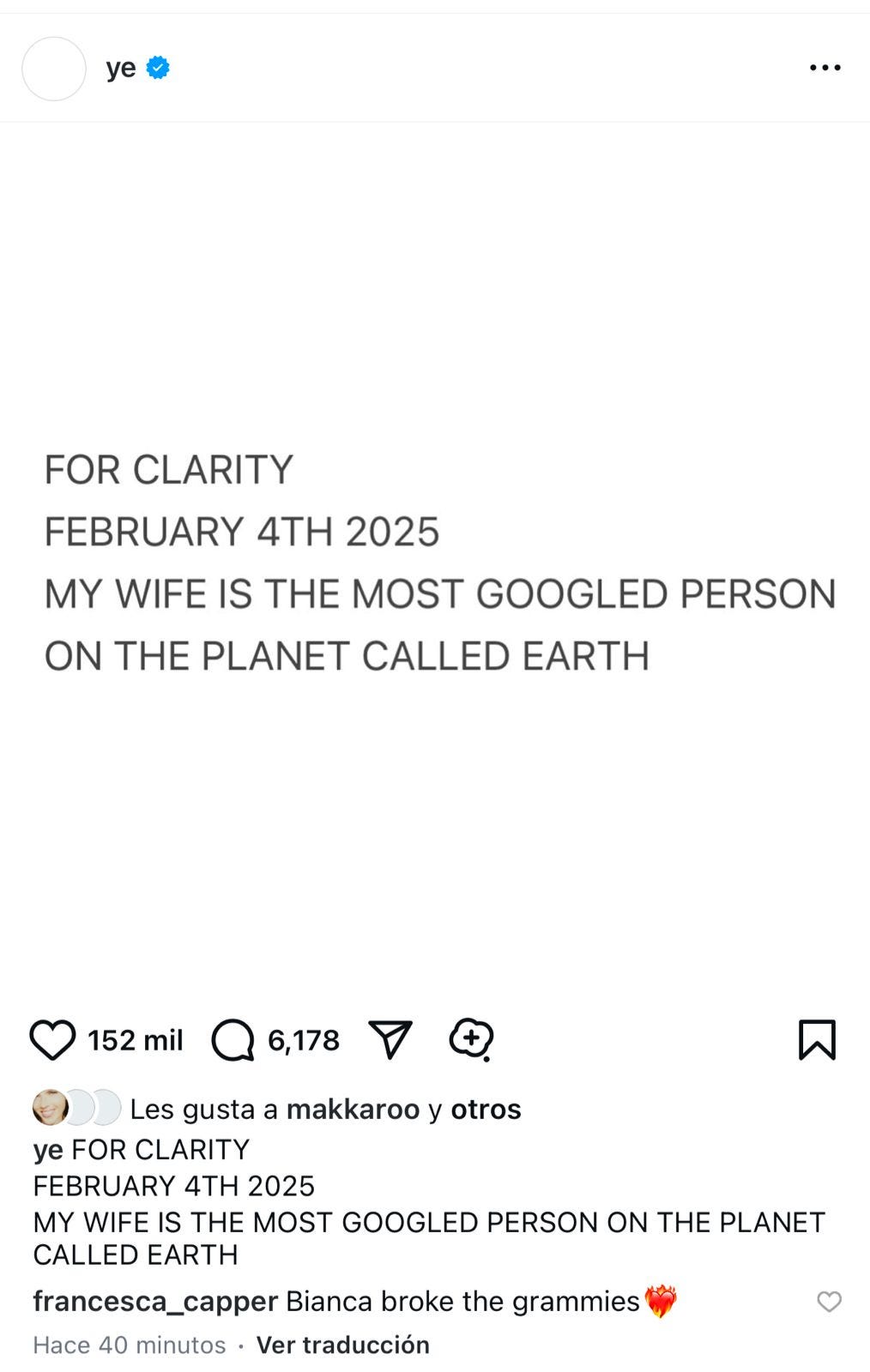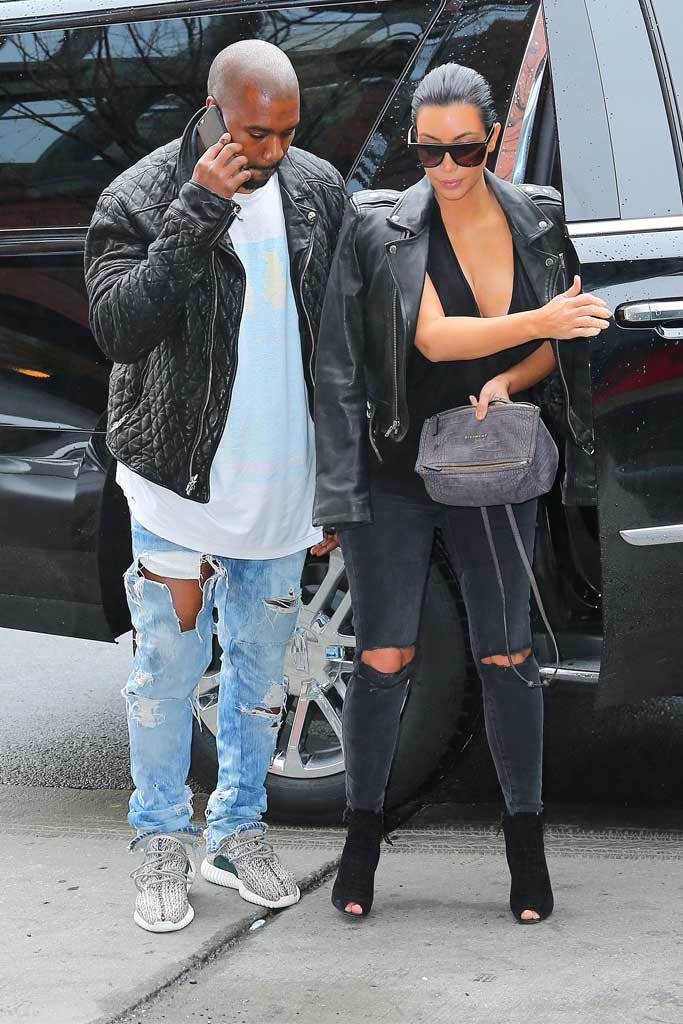Bianca Censori, Yeezy, and the Hegemonization of Fashion:
When Erotic Capital and Simplicity Dominate Design
It’s curious: at this very moment, I’m doing exactly what Kanye West wants. I’m talking about him, analyzing his strategy, giving him space in the conversation. And the thing is, Kanye doesn’t just make music and design clothes—he designs narratives.
On his Instagram, which he’s turned into a marketing strategy playground, he recently posted that his wife, Bianca Censori, is "the most searched person on the internet." Hours later, he deleted the posts and replaced them with an image of a Yeezy garment. This move isn’t random: it’s a calculated strategy to use Bianca’s erotic capital as bait and redirect attention to his products.
But what are these products? If we analyze Yeezy’s fashion from a design perspective, the answer is obvious: basics. Silhouettes without complex patterns, minimalist textiles, unstructured cuts. It’s a business model that aims to sell as much as possible with the least effort. But the key lies in the packaging: controversy, erotic capital, and shock value.
Kanye West and the Creation of "It Girls": From Kim Kardashian to Bianca Censori
Since his relationship with Kim Kardashian, Kanye has been a shaping force in the image of his partners. With Kim, he transformed her style through luxury brands and collaborations with renowned designers, turning her into a global fashion icon. Now, with Bianca Censori, he seems to be repeating the same formula. Bianca, an Australian architect and designer, has been visually redesigned by Kanye, adopting an aesthetic that many have compared to Kim’s: minimalist, neutral, and, above all, controversial.
This phenomenon aligns with Laura Mulvey’s (1975) theory of the "male gaze," which argues that women in media are presented as objects of desire within a narrative that privileges the male perspective. Throughout his career, Kanye has understood and manipulated this phenomenon to his advantage, molding his partners into extensions of his brand and creative vision.
Recently, Kanye shared images of Bianca on his Instagram, boasting that she was the most searched person on the internet. Hours later, he deleted the posts and replaced them with an image of a Yeezy garment. This move isn’t random: it’s a calculated strategy to use Bianca’s erotic capital as bait and redirect attention to his products. But what lies behind these products? Do they really justify the spectacle surrounding them?
The Simplicity of Yeezy: When the Lack of Creative Design Becomes Trend
As a fashion designer, I can’t help but notice the lack of complexity in Yeezy’s designs. The garments are basic, with simple silhouettes and a neutral color palette that borders on monotony. There’s no innovative pattern-making, no cuts that challenge conventions, no details that demonstrate technical mastery of design. Instead, what we see is a hegemonization of aesthetics: everything becomes flat, simple, and repetitive.
This is no accident. Kanye knows that in the era of late capitalism, a product’s value lies not in its quality or complexity, but in the narrative surrounding it. Fredric Jameson (1991) explains how postmodernism in capitalism relies on repetition and simulation rather than genuine innovation. Yeezy has become proof of this, selling the illusion of exclusivity rather than truly disruptive design. (And that’s why many of his followers call him a genius.)
Jean Baudrillard (1981) reinforces this idea with his concept of "hyperreality," where fashion isn’t about clothing itself, but about the image constructed around it. Yeezy’s clothing embodies this principle: a garment doesn’t need to be technically innovative if it’s backed by a powerful enough narrative.
Erotic Capital as a Marketing Tool
The concept of erotic capital, developed by sociologist Catherine Hakim (2010), refers to the power of image and sexuality in society. Kanye West is a master at using this capital to sell his products. With Kim Kardashian, he did it through an aesthetic that combined luxury and provocation. With Bianca Censori, he repeats the formula, but with a twist: Bianca’s image isn’t just erotic—it’s also controversial, which generates even more attention.
Naomi Wolf (1990) argues in The Beauty Myth that the female image in capitalism isn’t just exploited but strategically designed to serve commercial purposes. In this context, Bianca isn’t just a woman—she’s a sellable narrative: a combination of desire, power, and provocation that becomes a tool for consumption. And Kanye knows this all too well—they’re cashing in.
The Hegemonization of Fashion: When Simplicity Dominates
The most concerning aspect of all this isn’t just the exploitation of erotic capital, but the hegemonization of aesthetics promoted by Yeezy. By prioritizing simplicity and neutrality, Kanye is contributing to a homogenization of fashion where flatness and basics become the norm. This not only limits designers’ creativity but also reinforces Eurocentric standards of beauty and style.
From a sociological perspective, Pierre Bourdieu (1986) argues that "cultural capital" defines prestige within creative industries. In this case, the aesthetic imposed by Kanye reinforces a cultural capital based on repetition and standardization, eliminating the diversity and experimentation that characterize true innovation in fashion.
Angela McRobbie (1997) contends that fashion should serve as a platform for resistance and self-expression, not as a machine of repetition. Yeezy, however, is closer to the standardization of identity than its diversification.
Conclusion: Toward a More Critical and Authentic Fashion
The story of Kanye West, Bianca Censori, and Yeezy reflects the most problematic dynamics of the fashion industry: the exploitation of erotic capital, the hegemonization of aesthetics, and the prioritization of marketing over design. But it’s also an opportunity to reflect on how we, as consumers and creators, can demand more.
We need a fashion that values authenticity, creativity, and ethics over spectacle. We need designers who challenge conventions rather than perpetuate them. And, above all, we need an industry that stops seeing women as objects and recognizes them as subjects with agency and power.
Also, let’s not forget: Kanye understands how the consumption system works. Kim Kardashian is his success story, but she no longer belongs to him. Bianca Censori does, and we’re witnessing a marketing strategy to introduce Yeezy’s women’s line through the objectification of women, as has always been done. In this era where Donald Trump is president, it’s clear to me how the right wing is still present everywhere.
Buy local brands.
Buy Latin brands.
Buy Mexican brands.
References:
Baudrillard, J. (1981). Simulacra and Simulation. University of Michigan Press.
Hakim, C. (2010). Erotic Capital. European Sociological Review.
Klein, N. (2000). No Logo. Picador.
McRobbie, A. (1997). The Uses of Cultural Studies. Sage Publications.
Mulvey, L. (1975). Visual Pleasure and Narrative Cinema. Screen.
Wolf, N. (1990). The Beauty Myth. HarperCollins.
Jameson, F. (1991). Postmodernism, or, The Cultural Logic of Late Capitalism. Duke University Press.
Bourdieu, P. (1986). The Forms of Capital. Greenwood Press.








